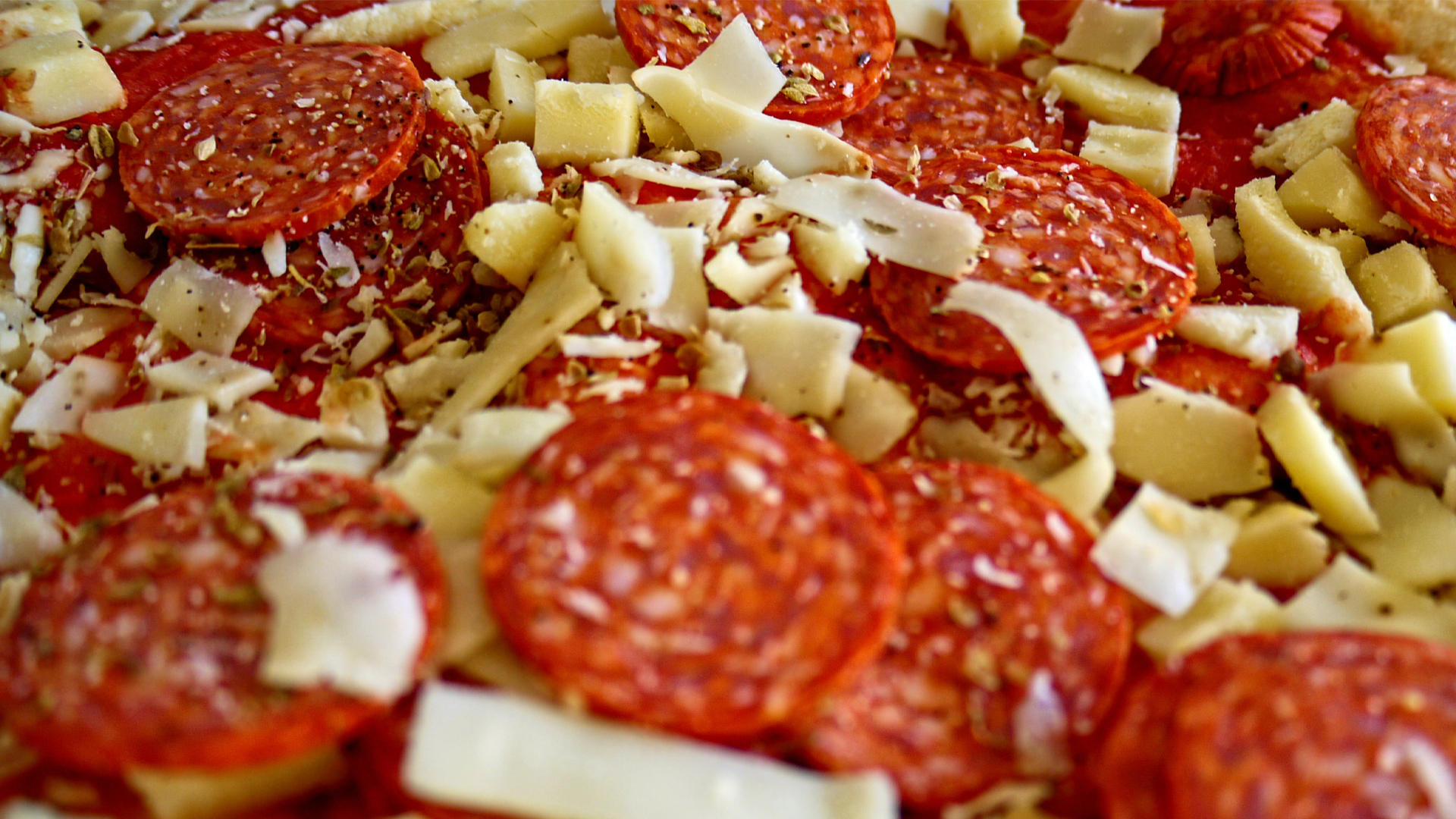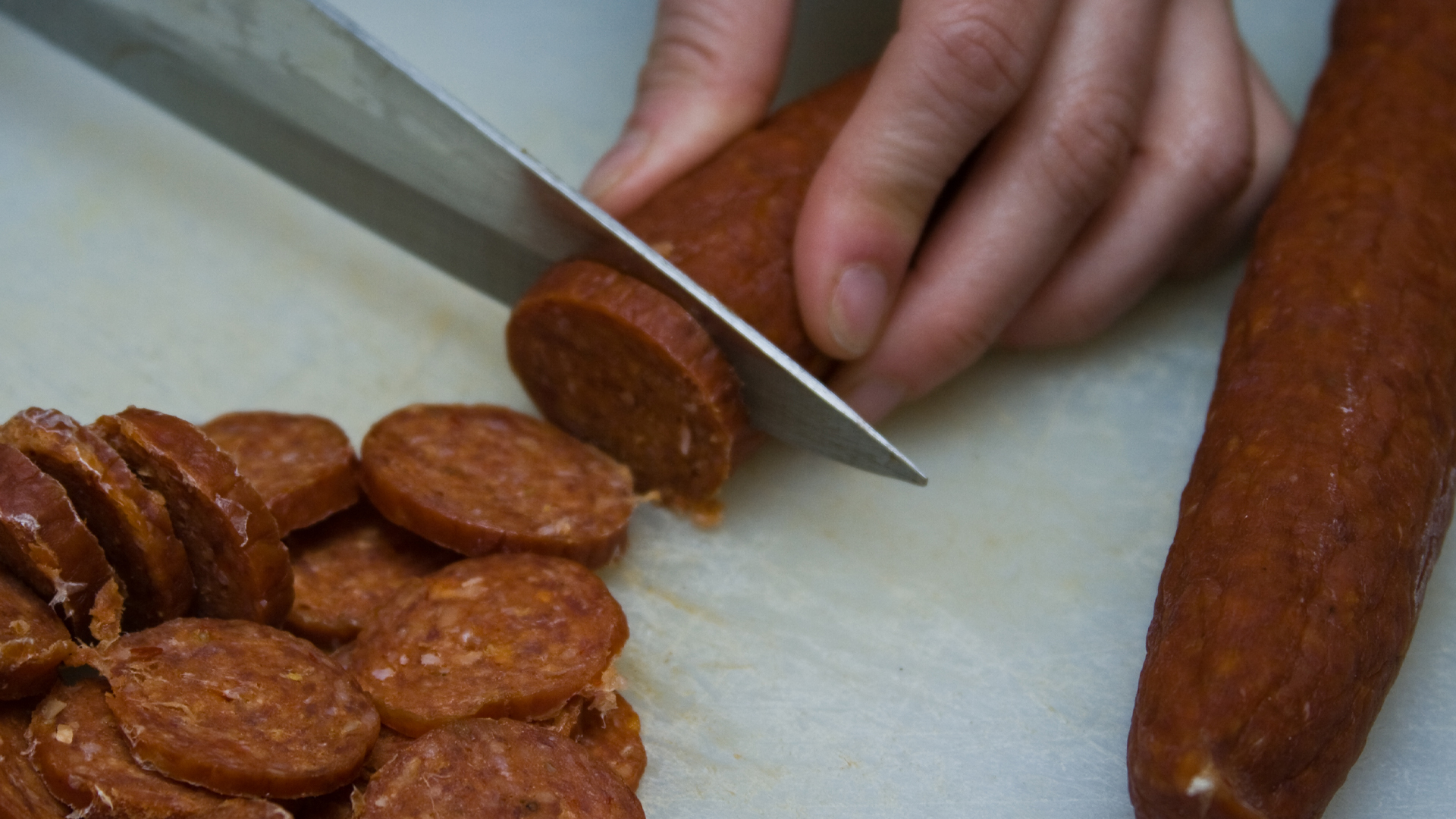Pepperoni is America's favorite pizza topping but, just about anything can become a pizza topping these days. Creative pizzaiolos have moved beyond tossing pineapple on a pie, offering everything from smoked lox to Caribbean-style braised oxtail.
Surveys of Americans have found that spicy, dry sausage regularly prevails over toppings like sweet Italian sausage, mushrooms, and onions. A 2021 survey found almost two-thirds of respondents preferred pepperoni.
Pepperoni is Not Italian
Despite its popularity in America, you won't find pepperoni in Italy.
A few elements distinguish pepperoni from other Italian sausages. It's a combination of ground pork and beef, but with a relatively high-fat content, around 30-35%. The sausage is also slightly fermented before its dry-aged, with the distinctive flavor coming from paprika. In addition, crushed red pepper and mustard give the sausage a distinctive sting, and artisan producers might add even more secret spices.
The paprika offers a clue to its origins. The spice is more closely linked to Eastern Europeans than Italy suggesting Italian immigrants created the sausage by drawing on influences in their adopted home surrounded by other ethnic immigrant groups rather than relying purely on old-world Italian roots.

Similar Meats in Italy
That's not to say there aren't some sausages similar to pepperoni in Italy. Third-generation sausage maker Patti Fortuna-Stannard is cited in Rachel Wharton's American Food: A Not-So-Serious History, explaining how her Calabrian ancestors made a bright red, spicy sausage similar to pepperoni. Although they didn't call the sausage pepperoni, the spice level and texture were similar. Another distinguishing characteristic of this popular spiced meat is how finely ground the meat is compared to other Italian sausages.
Italian immigrants invented pepperoni around the turn of the 20th century. Since most recipes include crushed red pepper, the sausage borrowed the Italian term "peperone," meaning pepper. Different spellings for it have been used, and it wasn't until the 1920s that the standard “pepperoni” came to universally mean spicy, dry-aged sausages everywhere.
Pepperoni Origins
Pepperoni, the sausage, did exist in some form before the 1920s. The Gateway, a turn-of-the-century magazine focused on arts and culture in Michigan, published a 1908 article about the purity of sausages, and includes pepperoni in the list of varieties. The list distinguishes it from other Italian sausages like Milano salami and soppressata but stops short of discussing the ingredients or flavors.
Another early use of the term appears in a Kansas newspaper advertising a "Mortadella Pepperoni" as part of an Easter banquet. Without a description of the sausage, it's impossible to know how close to modern pepperoni this was. It might merely have been a mortadella with peppers rather than anything recognizable as pepperoni today.
Pepperoni grew in popularity in the 1920s in part because dry-age sausages received the endorsement of the United States Department of Agriculture. At the time, trichinosis posed a real threat to people who ate undercooked pork. In 1920, the Department of Agriculture released the results of a study that demonstrated dry-aged pork sausages like pepperoni were safe to eat.

Pepperoni in the Midwest
This was great news for coal miners in West Virginia. Pepperoni had become a popular lunch for the Italian immigrants in the state, especially since they worked long hours underground. In 1900, West Virginia had the highest population of American-born citizens than any other state, but just fifteen years later, so many Italians had relocated there to work the coal mines they had become the largest ethnic group. And they were eating a lot of sausages.
Coal-miner-turned-baker Giuseppe "Joseph" Argiro noticed many of his neighbors would take bread and pepperoni for lunch or dinner. The miners carried their lunch buckets down the shafts with them so shelf-stable pepperoni ensured their food wouldn't spoil. Argiro decided to take advantage of the fact and sometime between 1927 and the early 1930s, he combined the two into the now-famous West Virginia pepperoni roll.
Outside of West Virginia, pepperoni was marketed as a deli meat alongside imported Italian sausages. In the 1930s, advertisements began crafting the image of the sausage as an Italian product rather than a domestic invention. Compounding this misconception, many varieties of pepperoni were seasoned with imported peppers, furthering the idea that the sausage themselves were from Italy.
Popular Pizza Topping
Then pizza went mainstream. In post-war America, pizza expanded beyond the Italian enclaves, growing into part of the national cuisine. Pizzerias across the country advertised toppings like cheese, anchovies, and pepperoni.
Since that time, the two have been inseparable. However, not all pepperoni pizzas are the same. Pizzerias in the East Coast pizza belt have historically served up this meat cut into half-dollar-sized medallions, sliced thin, without casings. These bright red dots lay flat on pizza and are common on New York-style slices, grandma pies, and New York "Sicilian" slices.
In Buffalo and parts of the midwest, pizza is more likely to have pepperoni made from natural casings causing the coin-sized slices to curl up in the oven. The slices form "roni cups," also known as "cup and char" because of how the edges of the meat are charred in the oven.
Pepperoni today remains popular enough that some of the Neapolitan-style pizzerias now offer pies with the sausage. Just don't expect to get approval from Associazione Verace Pizza Neapoletana – the Association of the True Neapolitan Pizza.

